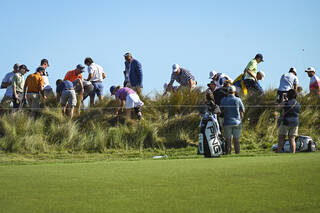Is the Leaf Rule in Golf Real? Here are the Facts
Here's everything you need to know about the leaf rule in golf

Like mulligans, breakfast balls, and preferred lies, golfers have been playing by the “leaf rule” for as long as leaves have fallen from trees, without knowing or caring whether or not it’s actually legal. Players who cite this leaf rule take a free drop when a ball is missing and it could be under leaves.
We’re here to clear the air (kind of) about the leaf rule, and just how legal it is.
The Leaf Rule
The reason we can only kind of clarify whether the leaf rule is real or not, is because it’s kind of a real Rule.
|
Ball Lost in Leaves |
Official Rules of Golf |
Model Local Rule F-14 |
|
Ruling |
Stroke and distance |
Free relief |
|
Procedure |
One stroke penalty, play from the spot of your previous shot. |
Find the nearest point of complete relief and drop within one club length, no closer to the hole. |
The Rules of Golf treat all lost balls equally, including a ball that’s lost in leaves (unless it’s lost in leaves piled by the maintenance staff outside of a penalty area for later removal), meaning you must take a one-stroke penalty and play from your previous shot, everyone’s favorite stroke-and-distance punishment.
The thing is, there’s a Model Local Rule that is much more lenient. When Model Local Rule F-14 is in effect, you’re in luck.
According to MLR F-14 “At certain times of the year, piles of loose impediments such as leaves, seeds or acorns may make it difficult for a player to find or play his or her ball. A Committee can choose to treat such piles of loose impediments in the general area or in a bunker as ground under repair from which free relief is allowed.”
In other words, when playing under the Local Rule, you can take free relief within one club length, no closer to the hole, from the nearest point of complete relief from the abnormal course condition – in this case, the leaves.
It's worth noting that if your ball is known or virtually certain to be in a pile of leaves that was made by the maitenance staff for later removal, those leaves are always considered to be ground under repair, and you get to play by the same procedures outlined in Model Local Rule F-14.

Lost Ball in Golf: Stroke and Distance Rule & Procedures
When Is This Local Rule In Effect?
The Rules of Golf would be no fun if the answers to our questions didn’t raise even more questions, and right now I’ll bet you’re wondering how you would know when this Local Rule is in effect.
The “Committee” determines which, if any, Local Rules are in effect. If you’re playing a competitive round or a tournament, the Committee is the person or group running that competition.
If you’re just playing a casual round then the Committee could be the golf course staff running the course. During general play, the members of your group can choose to take on the role of the Committee for your round to agree upon any rulings or Local Rules in effect.
That, however, does not mean you can simply make up your own rules. Any Local Rules you put into effect must be consistent with the guidelines outlined by the USGA. In fact, the USGA explicitly states that a Committee “must not use a Local Rule to waive or modify a Rule of Golf simply because it might prefer a Rule to be different.”
A New Leaf
If you’re just playing a casual round of fall golf with your buddies, and it’s clear that leaves could cause issues, it makes perfect sense to apply the Local Rule affectionately known as the leaf rule, as long as you use good judgment and don’t take advantage of it to skirt lost ball penalties.
Assigning the role of the Committee to yourself could be considered a loose interpretation of the Rules, and if you prefer to be even more by-the-book, just ask the starter or the course staff in the pro shop before you tee off if the Local Rule is in play to address leaves.
If you’re playing a competition, the Committee should clearly communicate whether or not the leaf rule is in effect, but it’s always a good idea to clarify before the competition begins so you know how to proceed.